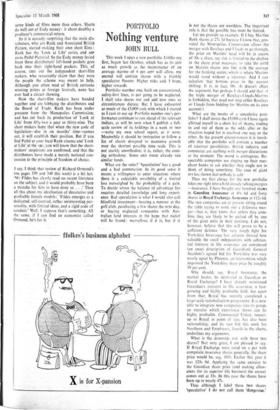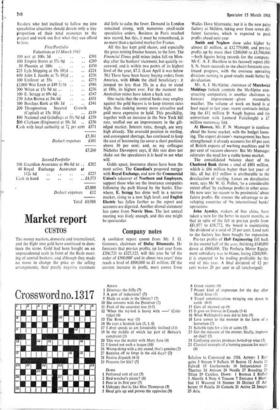. Nothing venture
PORTFOLIO JOHN BULL
This week I open a new portfolio. Unlike my . first, begun last October, which has as its aim as much growth as the maintenance of an average income of 4 per cent will allow, my second will contain shares with a frankly speculative flavour. Higher risks and. I hope, higher rewards.
Portfolio number one, built on conventional, safety-first lines, is not going to be neglected. I shall take shares out and add new ones as circumstances dictate. But I have exhausted as much of the £5,000 cash with which I started as I care to use up. Portfolio number one's per- formance continues to run ahead of the relevant indices, as will be seen when I publish a full- scale review of its holdings in a week or two —write my own school report, as it were. Meanwhile it should be instructive to follow a list of shares designed to maximise growth over the shortest possible time scale. This is not starkly unorthodox; it is, rather, the com- ing orthodoxy. Some unit trusts already run similar funds.
What are the rules? 'Speculation' has a good and a bad connotation. In its good sense it means a willingness to enter situations where there is a calculable possibility of a limited loss outweighed by the probability of a gain. To decide where the balance of advantage lies requires detailed knowledge and long experi- ence. Bad speculation is what I would also call blindfold investment—hearing a rumour at the golf club, purchasing a few shares the next day, or buying neglected companies with Aus- tralian land interests in the hope that nickel will be found : marvellous if it is, but if it
is not the shares are worthless. The important rule is that the possible loss must be limited.
Let me provide an example. If I buy Martins Bank shares at 27s 3d because I know that, pro- vided the Monopolies Commission allows the merger with Barclays and I loyds to go through, the price on Martins' head will be in excess of 30s a share, my risk is limited to the decline in the share price necessary to take the yield on Martins shares into line with the average for the banking sector, which is where Martins would stand without a takeover. And I can calculate that bottom price to the nearest shilling. It is, in fact, 18s. (It doesn't affect the argument, but perhaps I should add that If the triple merger of Barclays-Lloyds-Martins is forbidden, that need not stop either Barclays or Lloyds from bidding for Martins on its own account.)
What are the marks of a speculative port- folio? I shall invest the £5.000 cash I have again allotted myself in a short list of shares, trading in and out of them as the odds alter or the situation hoped for is resolved one way or the other. In the present circumstances it is inevit- able that the portfolio will contain a number of takeover possibilities. British industry and commerce are, seething with merger discussions at the moment. The mood is contagious. Re- spectable companies are ringing up their mer- chant banks to ask whether they ought not to think of doing something. The case of giant AEI has shown that nobody is safe.
Thus my first choice for the new portfolio takes me right into a field already talking mergers —insurance. I have bought one hundred shares in Guardian Assurance at 40s 6d and forty shares in Royal Exchange Assurance at 112s 6d. The two companies are at present sitting round the table trying to work out a defensive mer- ger—that is, they know that unless they com- bine they are likely to be picked off by one of the giant units in their territory.. I do not, however, believe that this will prove to be a sufficient defence. The very tough fight for Yorkshire Insurance last autumn showed how valuable the small independents with substan- tial interests in life assurance are considered (an exact description of Guardian). General Accident's agreed bid for Yorkshire was very nearly upset by Phoenix, an intervention which improved the Yorkshire share price by roughly 50 per cent.
Why should, say, Royal Insurance, the market leader, be interested in . Guardian or Royal Exchange? I have already mentioned Guardian's interests in life assurance, a fast- growing and highly profitable field: but apart from that, Royal has recently completed a large-scale rationalisation programme It is now able to integrate new companies into its group, an exercise which experience shows can be highly profitable. Commercial Union, runner- up to Royal in point of size, has also been rationalising; and its vast bid this week for Northern and Employers, fourth in the charts, underlines my arguments.
What is the downside risk with these two shares? Not very great, I am pleased to say. If Royal Exchange were rated on a par with composite insurance shares generally, the share price would be, say, 103s. Earlier this year it was 123s 9d. Applying the same exercise to the Guardian share price (and making allow- ances for its superior life business) the answer comes out at 33s. In this case the shares have been up to nearly 47s.
Thus although I label these two shares 'speculative' I do not call them 'dangerous.'
Readers who feel inclined to follow me into speculative situations should devote only a tiny proportion of their total resources to the project and work out first what they can afford to lose.
First Portfolio Valuations at 13 March 1963
100 BAT at 100s 3d .. £501
100 Empire Stores at 57s 9d .. • • £289 50 Phoenix at 180s.. £450 225 Lyle Shipping at 19s 1044:1 £224 600 John I. Jacobs at 7s 104d .. £236 100 Unilever at 55s .. • • £275 £2,000 War Loan at £49 5/16 £986 300 Witan at 15s 9d xc £236 100 E. Scragg at 69s 6d .. £347 250 John Brown at 34s 6d £431 100 Barclays Bank at 68s 3d £341 200 Throgmorton Secured Growth (Capital) at 15s 1044 £159 100 National and Grindlays at 51s 9d xd £259 SOO Clarkson (Engineers) at lOs 3d .. £256 Cash with local authority at 71 per cent £371 £5,361 Deduct: expenses £101 £5,260 Second Portfolio 100 Guardian Assurance at 40s 6d xc £202 '40 Royal Exchange Assurance at 112s 6d £225 Cash in hand .. .. £4,573 • £5,000 Deduct: expenses £12 Total £4,988











































 Previous page
Previous page